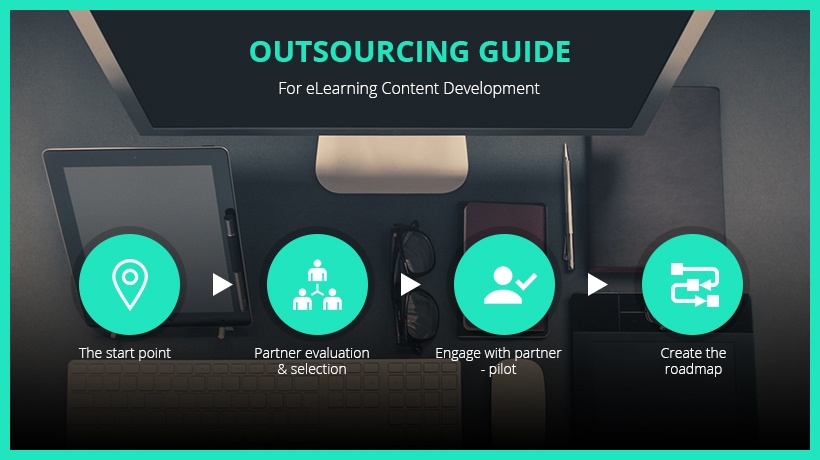How To Evaluate Your Current Online Resources Before eLearning Outsourcing
There are numerous advantages to taking stock of your online resources before eLearning outsourcing. First and foremost, it reduces development time and costs. Your vendor gets a head start on the eLearning project, as they don't have to evaluate your existing assets. You may also rediscover online resources that are ideal for your current eLearning project. As such, you're able to minimize the amount of work you outsource. Here are 7 tips to help you assess your online resources before handing them over to the vendor.
1. Pinpoint Your Objectives And Goals
Before you can gather and evaluate your resources, you need to know the desired outcome. Why are you outsourcing eLearning? What goals or objectives do you want to achieve? And how is the outsourcing company going to be able to help you in this regard? This allows you to determine which resources are worthwhile, and which can go by the wayside. Goals and objectives also give you the opportunity to choose the best vendor for the task. For example, a service provider who specializes in your specific niche or can provide you with the learning materials you require.
2. Meet With Your eLearning Vendor Early On
Once you've found the ideal eLearning vendor, it's wise to schedule a meeting as soon as possible. Have a list of questions on-hand, and apprise them of your goals, objectives, and desired outcomes. This is also the time to compare notes and take inventory of their assets, as they may already have tools and resources you need for the eLearning project, such as eLearning authoring tools or content that they can repurpose for the current eLearning course. You should arrange a meeting even if you've worked with the eLearning vendor in the past, as their resources, staffing, or expertise may have changed since the last eLearning project.
3. Get Your eLearning Team Onboard
Your eLearning team is one of your most valuable assets. They hold the knowledge, experience, and skills you need to effectively evaluate your eLearning resources. They can also offer their input and advice regarding how to proceed. For example, which key takeaways and training pain points you need to address early on. Schedule regular meetings with your collaborators and invite them to offer suggestions and recommendations. You should also ask them to evaluate their respective assets, which they can contribute to the eLearning project.
4. Repurpose Your Existing Online Assets
You may already have online resources that you can use for the current eLearning project, which might require some minor modifications. Doing so will save you time and money. For example, your eLearning vendor can remove these resources from their estimate, reducing the overall cost. This is yet another reason why you need to enlist the help of your team as soon as possible. Their unique insights and expertise gives you the opportunity to transform existing assets into new learning materials.
5. Adopt A Microlearning Mindset
Some of the resources you have in your repository may benefit from a microlearning makeover. For example, a comprehensive course turns into multiple modules, activities, and support resources. Analyze your existing materials and then break them down into smaller units, or compile bits and pieces from several different assets to create a targeted microlearning online resource. For instance, five different modules include information about a specific work-related task. You can gather all of these data points to create an effective microlearning online tutorial or activity, such as an interactive presentation that employees can use during their "moment of need". The key is to look at every asset from a microlearning perspective.
6. Tap Into The Power Of Big Data
You have a wealth of LMS reports, analytics, and other Big Data at your disposal. Why not use this information to make your next eLearning course even more powerful and profound? Big Data can reveal gaps in your current eLearning strategy, as well as strengths. For example, one of your modules has extremely low attendance rates, and online learners are struggling to complete the interactive simulation that accompanies the eLearning module. This usually indicates that there's a disconnect between the content and practical application. In other words, online learners are getting the information, but they cannot move from theory to practice. As a result, you may need to incorporate more real-world tie-ins, such as case studies and scenarios. This will provide them with the experience they require to absorb and assimilate the core concepts. All of this Big Data analysis can then be passed onto the eLearning vendor. Better still, you can use it to create more targeted learning objectives for the eLearning project you plan to outsource.
7. Survey Your Audience
Ultimately, your online learners are the ones who participate in the eLearning course. They are the ones who need the information to solve a common problem or complete a task. Therefore, they have a unique perspective of the situation that can help you evaluate your current online resources. For example, you conduct a survey or a focus group with a select group of online learners, and you notice that a vast majority of the participants enjoyed the interactive scenarios from your last compliance online training course. Thus, you can analyze those scenarios to see what they have in common and then apply your findings to your next eLearning project you outsource.
These 7 tips will help you compile, evaluate, and prepare your eLearning resources before you hand them over to the vendor. Also, keep in mind that communication is of the upmost importance. Maintain an open dialogue with your service provider and let them know about any new developments, such as additional assets that can help them produce even more effective eLearning deliverables.
Did your last outsourcing project not go according to plan? Are you looking for ways to take the headache out of the next course design partnership? Read the article 10 Tips To Take The Stress Out Of eLearning Outsourcing to reduce the stress associated with eLearning outsourcing.








